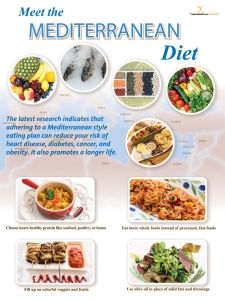4 Tips for Healthful Cooking
 National Nutrition Month is here, and the theme is Bite into a Healthy Lifestyle!Today, I want to help you help your clients reach that goal by offering 4 tried-and-true tips for healthful cooking. These tips all come from dietitians and scientific studies, and each tip has been rigorously tested by my team and me. Ready to see them for yourself?Tip #1: Replace Butter with Olive or Canola OilWhen it comes to savory cooking, a great way to improve the nutrient profile of your dish is to replace butter with olive or canola oil. This works well in sautés, stir fries, soups, and more! You can even dip bread in olive oil rather than slathering it in butter.Why make this switch?
National Nutrition Month is here, and the theme is Bite into a Healthy Lifestyle!Today, I want to help you help your clients reach that goal by offering 4 tried-and-true tips for healthful cooking. These tips all come from dietitians and scientific studies, and each tip has been rigorously tested by my team and me. Ready to see them for yourself?Tip #1: Replace Butter with Olive or Canola OilWhen it comes to savory cooking, a great way to improve the nutrient profile of your dish is to replace butter with olive or canola oil. This works well in sautés, stir fries, soups, and more! You can even dip bread in olive oil rather than slathering it in butter.Why make this switch?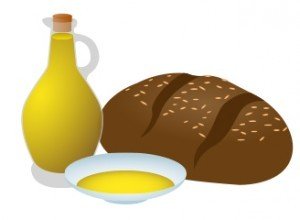 Both butter and olive oil are calorie-dense, high-fat foods. But there is a significant difference in the types of fats they contain. Butter is rich in saturated fat, a solid fat that can increase a person's risk of chronic disease, especially heart disease. According to the Dietary Guidelines for Americans, "A strong body of evidence indicates that higher intake of most dietary saturated fatty acids is associated with higher levels of blood total cholesterol and low-density lipoprotein (LDL) cholesterol. Higher total and LDL cholesterol levels are risk factors for cardiovascular disease."So what's a health-conscious person to do?Switch to unsaturated fats.
Both butter and olive oil are calorie-dense, high-fat foods. But there is a significant difference in the types of fats they contain. Butter is rich in saturated fat, a solid fat that can increase a person's risk of chronic disease, especially heart disease. According to the Dietary Guidelines for Americans, "A strong body of evidence indicates that higher intake of most dietary saturated fatty acids is associated with higher levels of blood total cholesterol and low-density lipoprotein (LDL) cholesterol. Higher total and LDL cholesterol levels are risk factors for cardiovascular disease."So what's a health-conscious person to do?Switch to unsaturated fats.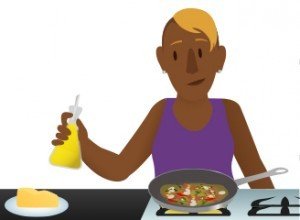 There are two types of unsaturated fats -- polyunsaturated fats and monounsaturated fats. You can find monounsaturated fats in foods like avocados, nuts, canola oil, sunflower oil, and olive oil. You can find polyunsaturated fats in safflower oil, canola oil (yes, both types of fat are present in this one), flaxseeds, fatty fish, and walnuts. These fats promote heart health and offer vital nutrients, making them a great substitute for saturated fats. Many studies have supported this assertion, including Saturated Fatty Acids and Risk of Coronary Heart Disease: Modulation by Replacement Nutrients by Patty W. Siri-Tarino, Qi Sun, Frank B. Hu, and Ronald M. Krauss. The team asserts "Studies in animals and humans support the concept that replacement of saturated fats with polyunsaturated fats results in improved lipid profiles, specifically, decreased [total cholesterol] and LDL cholesterol with minimal decreases in HDL cholesterol, as well as with decreased CVD risk," calling the observation that unsaturated fats were a great replacement for saturated fats "well-established." Even the Dietary Guidelines make this assertion, adding a caveat about fat content. "Consuming less than 10 percent of calories from saturated fatty acids and replacing them with monounsaturated and/or polyunsaturated fatty acids is associated with low blood cholesterol levels, and therefore a lower risk of cardiovascular disease."
There are two types of unsaturated fats -- polyunsaturated fats and monounsaturated fats. You can find monounsaturated fats in foods like avocados, nuts, canola oil, sunflower oil, and olive oil. You can find polyunsaturated fats in safflower oil, canola oil (yes, both types of fat are present in this one), flaxseeds, fatty fish, and walnuts. These fats promote heart health and offer vital nutrients, making them a great substitute for saturated fats. Many studies have supported this assertion, including Saturated Fatty Acids and Risk of Coronary Heart Disease: Modulation by Replacement Nutrients by Patty W. Siri-Tarino, Qi Sun, Frank B. Hu, and Ronald M. Krauss. The team asserts "Studies in animals and humans support the concept that replacement of saturated fats with polyunsaturated fats results in improved lipid profiles, specifically, decreased [total cholesterol] and LDL cholesterol with minimal decreases in HDL cholesterol, as well as with decreased CVD risk," calling the observation that unsaturated fats were a great replacement for saturated fats "well-established." Even the Dietary Guidelines make this assertion, adding a caveat about fat content. "Consuming less than 10 percent of calories from saturated fatty acids and replacing them with monounsaturated and/or polyunsaturated fatty acids is associated with low blood cholesterol levels, and therefore a lower risk of cardiovascular disease."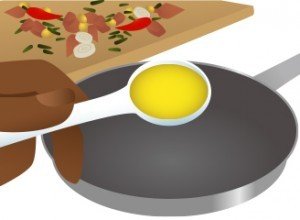 Wait, why the caveat about 10%? Well, all fats are dense in calories, and all should be consumed in moderation. That's why it's best to replace foods like butter with unsaturated alternatives, rather than add those unsaturated fats on top of the saturated fats already in play. Replacing the butter in a recipe with an unsaturated oil is a great place to start.For inspiration, here are a few recipes that feature oils instead of butter.
Wait, why the caveat about 10%? Well, all fats are dense in calories, and all should be consumed in moderation. That's why it's best to replace foods like butter with unsaturated alternatives, rather than add those unsaturated fats on top of the saturated fats already in play. Replacing the butter in a recipe with an unsaturated oil is a great place to start.For inspiration, here are a few recipes that feature oils instead of butter.
- Bread Machine Pizza
- Roasted Tomato Basil Spaghetti
- Tuna in a Sicilian Tomato Sauce
- Zucchini Squash Sauté
Tip #2: Use Herbs and Spices to Add Flavor to Dishes and Skip the SaltWe've been talking a lot about the dangers of too much salt lately. Remember How Much Salt is in Your Soup? and Which Grains Contain Too Much Salt? Those posts go in-depth about why a diet that is overloaded with sodium is bad for your health. And really, it all comes down to heart health.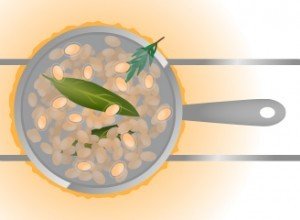 Perhaps the Dietary Guidelines for Americans say it best when they assert, "On average, the higher an individual’s sodium intake, the higher the individual’s blood pressure. […] Keeping blood pressure in the normal range reduces an individual’s risk of cardiovascular disease, congestive heart failure, and kidney disease. Therefore, adults and children should limit their intake of sodium."So, what does salt intake have to do with cooking?Well, salt is often used as a way to add flavor to dishes. But it is not the only way. The flavor exploration series from 2014 offered a wide variety of ways to boost the flavor of a dish without using excessive sodium. It all comes down to spices and herbs. Consider throwing some bay leaves and granulated garlic into your next pot of beans instead of salt, or topping your fish or chicken with fresh thyme and lemon instead of more salt. Here is a closer look at other ways to add zing to dishes without adding salt.
Perhaps the Dietary Guidelines for Americans say it best when they assert, "On average, the higher an individual’s sodium intake, the higher the individual’s blood pressure. […] Keeping blood pressure in the normal range reduces an individual’s risk of cardiovascular disease, congestive heart failure, and kidney disease. Therefore, adults and children should limit their intake of sodium."So, what does salt intake have to do with cooking?Well, salt is often used as a way to add flavor to dishes. But it is not the only way. The flavor exploration series from 2014 offered a wide variety of ways to boost the flavor of a dish without using excessive sodium. It all comes down to spices and herbs. Consider throwing some bay leaves and granulated garlic into your next pot of beans instead of salt, or topping your fish or chicken with fresh thyme and lemon instead of more salt. Here is a closer look at other ways to add zing to dishes without adding salt.
Oh, and before we leave this tip, it should be noted that most of the salt in the diet comes not from the salt shaker but from processed foods, especially canned and frozen foods. However, this tip can still help improve the nutrient profile of foods and is just as effective when adding flavor to no-salt-added cans of beans, broth, or tomatoes. Choose low-sodium foods, then boost their flavor with herbs and spices!Tip #3: Replace Half the Butter in Baked Goods with Fruit Purees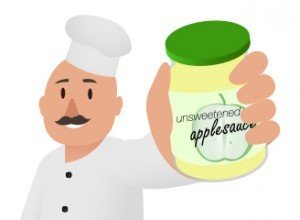 We've covered this ground before too, most recently on the Nutrition Education Store blog. In the post Substitute a Fruit for a Fat, Cheryle Jones Syracuse, MS, Professor Emeritus at The Ohio State University, explored ways to use applesauce and prune puree as butter replacements in recipes. Here's what she found...
We've covered this ground before too, most recently on the Nutrition Education Store blog. In the post Substitute a Fruit for a Fat, Cheryle Jones Syracuse, MS, Professor Emeritus at The Ohio State University, explored ways to use applesauce and prune puree as butter replacements in recipes. Here's what she found...
- Only use these purees to replace half the butter, keep the other half for its role in structure and flavor.
- Do this for sweet baked goods only.
- Use applesauce in lighter-hued dishes like apple cakes or cookies.
- Use prune puree in darker-hued dishes like brownies or chocolate cupcakes.
- Choose unsweetened applesauce and prunes.
The applesauce and prune puree add great moisture to these baked goods, and using them to replace half the butter also means that your sweet treat will get a boost of fiber and nutrients too. Every bit helps, because "Dietary fiber [...] may help reduce blood cholesterol levels and may lower risk of heart disease, obesity, and type 2 diabetes. Fiber is important for proper bowel function. It helps reduce constipation and diverticulosis. Fiber-containing foods [...] help provide a feeling of fullness with fewer calories" (MyPlate). So add some fiber to your baking projects and take steps to improve your health!Tip #4: Increase the Fruits and Vegetables in Your MealsFor today's last tip, it's time to amp up the fruits and veggies! Can you add more fruits and vegetables to your meals?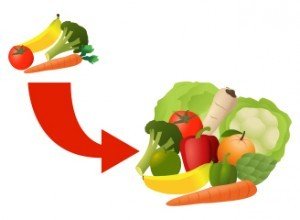 These foods are rich in fiber, the health benefits of which we have already covered above. That said, do note that the Dietary Guidelines for Americans advise people to just straight up "Choose foods that provide more potassium, dietary fiber, calcium, and vitamin D, which are nutrients of concern in American diets." Why are they nutrients of concern, you ask? Well, because most people don't get enough of them!Fruits and vegetables have a lot more to offer. They are loaded with key nutrients, especially vitamin A, vitamin C, potassium, and folate. These elements are all vital for good health and a balanced diet. Perhaps the Centers for Disease Control and Prevention (CDC) summed it up best when it asserted, "Healthy diets rich in fruits and vegetables may reduce the risk of cancer and other chronic diseases. Fruits and vegetables also provide essential vitamins and minerals, fiber, and other substances that are important for good health. Most fruits and vegetables are naturally low in fat and calories and are filling." What's not to love?
These foods are rich in fiber, the health benefits of which we have already covered above. That said, do note that the Dietary Guidelines for Americans advise people to just straight up "Choose foods that provide more potassium, dietary fiber, calcium, and vitamin D, which are nutrients of concern in American diets." Why are they nutrients of concern, you ask? Well, because most people don't get enough of them!Fruits and vegetables have a lot more to offer. They are loaded with key nutrients, especially vitamin A, vitamin C, potassium, and folate. These elements are all vital for good health and a balanced diet. Perhaps the Centers for Disease Control and Prevention (CDC) summed it up best when it asserted, "Healthy diets rich in fruits and vegetables may reduce the risk of cancer and other chronic diseases. Fruits and vegetables also provide essential vitamins and minerals, fiber, and other substances that are important for good health. Most fruits and vegetables are naturally low in fat and calories and are filling." What's not to love?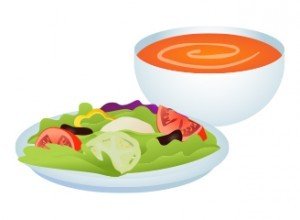 Now let's look at some examples. Here are some hot tips, followed by blog posts that offer ways to make those strategies happen in your day-to-day life. How can you get more fruits and vegetables in your diet?
Now let's look at some examples. Here are some hot tips, followed by blog posts that offer ways to make those strategies happen in your day-to-day life. How can you get more fruits and vegetables in your diet?
- Add a side salad to your lunch or dinner.
- Roast or steam some vegetables to serve with your meal.
- Choose fruit for dessert.
- Free Fruit Dessert Cookbook
- Fruit Dessert How-To Video Series
- 7 Remarkable Fruit Desserts
- Snack on fruits and vegetables.
Phew! Those 4 tips sure did cover a lot! But there's lots more to learn about nutrition. This post just offers one of many starting points. So if you'd like to start things off right with your clients (or reenergize their commitment to a healthful lifestyle) consider offering this free handout, which shines a spotlight on the first tip we discussed today.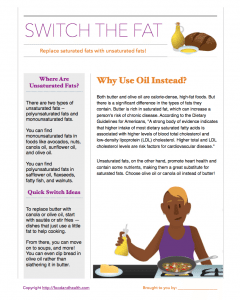 And, of course, there's tons more in the store! Check out these new features...
And, of course, there's tons more in the store! Check out these new features...

